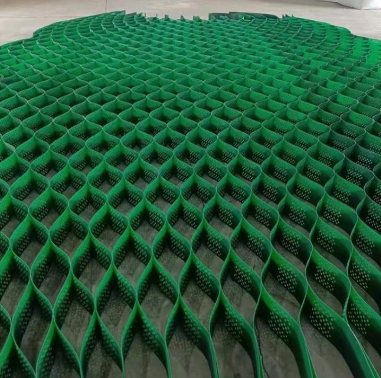- Understanding the Role of Geomembrane Liners in Waste Management
- Innovations in Geomembrane Liners for Water Management
- Geomembrane Liners: A Comprehensive Guide
- The Future of Geomembrane Liners in Civil Engineering
- Geomembrane Liners: Enhancing Landfill Stability
Manager:Alvin Wang
WhatsApp:+62 8983806051
Tel:+86 10-5797-1075
Email:steelwang@okorder.com
Address:3rd Floor, No.2 Building, No.1 Sanlihe Road
What is the purpose of a geogrid?
Geogrids, a fundamental component of geotechnical engineering, play a vital role in various civil engineering applications. One of the critical applications where geogrids shine is in slope protection, particularly in the form of geocells. This article delves into the purpose of geogrids, with a specific focus on their role in slope protection, exploring the benefits and mechanisms of geocell slope protection systems.

Understanding Geogrids:
Before delving into the specifics of geocell slope protection, it's essential to grasp the concept of geogrids. Geogrids are synthetic materials typically made from polymers like polyethylene, polyester, or polypropylene. These materials are formed into a grid-like structure, featuring apertures that allow for soil or aggregate interlock. The primary function of geogrids is to provide reinforcement to soil, enhancing its mechanical properties such as tensile strength and stiffness.
Introduction to Geocell Slope Protection:
Slope protection is a critical aspect of infrastructure development, particularly in areas prone to erosion or landslide risks. Geocell slope protection, also known as slope protection geocell, offers an innovative solution to stabilize slopes and prevent erosion. Geocells are three-dimensional cellular confinement systems made from interconnected polymer strips, forming a honeycomb-like structure when expanded. These cells are filled with soil, creating a stable and erosion-resistant surface.
Enhanced Stability:
One of the primary purposes of geocell slope protection is to enhance the stability of slopes. Traditional slope protection methods often involve the use of concrete structures or riprap, which can be costly and labor-intensive. Geocell slope protection offers a more cost-effective and environmentally friendly alternative by utilizing lightweight materials that are easy to transport and install.
The interconnected cells of the geocell system effectively confine the soil, preventing it from shifting or eroding during heavy rainfall or seismic activity. This confinement improves the overall stability of the slope, reducing the risk of landslides and erosion.
Erosion Control:
Erosion control is another critical purpose of geocell slope protection. Slopes are particularly vulnerable to erosion, especially in areas with steep gradients or sparse vegetation. Geocell slope protection systems provide a stable surface that helps to mitigate erosion by reducing surface runoff and promoting vegetation growth.
The porous nature of geocells allows water to infiltrate into the soil, preventing surface runoff and minimizing the risk of erosion. Additionally, the confinement provided by the geocell system helps to anchor vegetation roots, further stabilizing the slope and enhancing erosion control efforts.
Flexibility and Adaptability:
One of the significant advantages of geocell slope protection systems is their flexibility and adaptability to various terrain conditions. Unlike rigid structures such as concrete walls or embankments, geocells can conform to the natural contours of the slope, providing a seamless and aesthetically pleasing solution.
Furthermore, geocells can be easily customized to accommodate different slope angles and soil types. This versatility makes them suitable for a wide range of slope protection applications, from highway embankments to coastal cliffs.
Environmental Benefits:
In addition to their technical advantages, geocell slope protection systems offer significant environmental benefits. Traditional slope protection methods often involve the excavation and transport of large quantities of natural materials, leading to habitat destruction and ecosystem disruption.
Geocells minimize environmental impact by using lightweight materials and requiring less excavation. Furthermore, the porous structure of geocells promotes natural vegetation growth, enhancing biodiversity and restoring ecosystem balance.

Conclusion:
In conclusion, the purpose of a geogrid, particularly in the context of slope protection, is to enhance stability, control erosion, and provide a cost-effective and environmentally friendly solution. Geocell slope protection systems harness the inherent strength of geogrids to create stable and erosion-resistant surfaces that adapt to varying terrain conditions. By leveraging the benefits of geocell technology, engineers and developers can mitigate slope hazards effectively while minimizing environmental impact."






